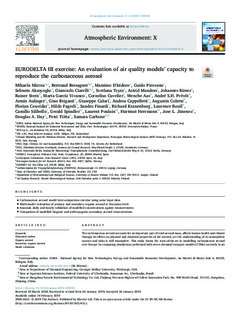EURODELTA III exercise: An evaluation of air quality models' capacity to reproduce the carbonaceous aerosol
| dc.contributor.author | Mircea, Mihaela | |
| dc.contributor.author | Bessagnet, Bertrand | |
| dc.contributor.author | D'Isidoro, Massimo | |
| dc.contributor.author | Pirovano, Guido | |
| dc.contributor.author | Aksoyoglu, Sebnem | |
| dc.contributor.author | Ciarelli, Giancarlo | |
| dc.contributor.author | Tsyro, Svetlana | |
| dc.contributor.author | Manders, Astrid | |
| dc.contributor.author | Bieser, Johannes | |
| dc.contributor.author | Stern, Rainer | |
| dc.contributor.author | Vivanco, Marta García | |
| dc.contributor.author | Cuvelier, Cornelius | |
| dc.contributor.author | Aas, Wenche | |
| dc.contributor.author | Prévôt, André S.H. | |
| dc.contributor.author | Aulinger, Armin | |
| dc.contributor.author | Briganti, Gino | |
| dc.contributor.author | Calori, Giuseppe | |
| dc.contributor.author | Cappelletti, Andrea | |
| dc.contributor.author | Colette, Augustin | |
| dc.contributor.author | Couvidat, Florian | |
| dc.contributor.author | Fagerli, Hilde | |
| dc.contributor.author | Finardi, Sandro | |
| dc.contributor.author | Kranenburg, Richard | |
| dc.contributor.author | Rouil, Laurence | |
| dc.contributor.author | Silibello, Camillo | |
| dc.contributor.author | Spindler, Gerald | |
| dc.contributor.author | Poulain, Laurent | |
| dc.contributor.author | Herrmann, Hartmut | |
| dc.contributor.author | Jimenez, Jose L. | |
| dc.contributor.author | Day, Douglas A. | |
| dc.contributor.author | Tiitta, Petri | |
| dc.contributor.author | Carbone, Samara | |
| dc.date.accessioned | 2019-05-08T07:28:58Z | |
| dc.date.available | 2019-05-08T07:28:58Z | |
| dc.date.created | 2019-04-24T11:06:59Z | |
| dc.date.issued | 2019 | |
| dc.identifier.issn | 2590-1621 | |
| dc.identifier.uri | http://hdl.handle.net/11250/2596901 | |
| dc.description.abstract | The carbonaceous aerosol accounts for an important part of total aerosol mass, affects human health and climate through its effects on physical and chemical properties of the aerosol, yet the understanding of its atmospheric sources and sinks is still incomplete. This study shows the state-of-the-art in modelling carbonaceous aerosol over Europe by comparing simulations performed with seven chemical transport models (CTMs) currently in air quality assessments in Europe: CAMx, CHIMERE, CMAQ, EMEP/MSC-W, LOTOS-EUROS, MINNI and RCGC. The simulations were carried out in the framework of the EURODELTA III modelling exercise and were evaluated against field measurements from intensive campaigns of European Monitoring and Evaluation Programme (EMEP) and the European Integrated Project on Aerosol Cloud Climate and Air Quality Interactions (EUCAARI). Model simulations were performed over the same domain, using as much as possible the same input data and covering four seasons: summer (1–30 June 2006), winter (8 January – 4 February 2007), autumn (17 September- 15 October 2008) and spring (25 February - 26 March 2009). The analyses of models’ performances in prediction of elemental carbon (EC) for the four seasons and organic aerosol components (OA) for the last two seasons show that all models generally underestimate the measured concentrations. The maximum underestimation of EC is about 60% and up to about 80% for total organic matter (TOM). The underestimation of TOM outside of highly polluted area is a consequence of an underestimation of secondary organic aerosol (SOA), in particular of its main contributor: biogenic secondary aerosol (BSOA). This result is independent on the SOA modelling approach used and season. The concentrations and daily cycles of total primary organic matter (TPOM) are generally better reproduced by the models since they used the same anthropogenic emissions. However, the combination of emissions and model formulation leads to overestimate TPOM concentrations in 2009 for most of the models. All models capture relatively well the SOA daily cycles at rural stations mainly due to the spatial resolution used in the simulations. For the investigated carbonaceous aerosol compounds, the differences between the concentrations simulated by different models are lower than the differences between the concentrations simulated with a model for different seasons. | |
| dc.language.iso | eng | nb_NO |
| dc.rights | Attribution-NonCommercial-NoDerivatives 4.0 Internasjonal | * |
| dc.rights.uri | http://creativecommons.org/licenses/by-nc-nd/4.0/deed.no | * |
| dc.title | EURODELTA III exercise: An evaluation of air quality models' capacity to reproduce the carbonaceous aerosol | nb_NO |
| dc.type | Journal article | nb_NO |
| dc.description.version | publishedVersion | nb_NO |
| dc.rights.holder | © 2019 The Authors. Published by Elsevier Ltd. | nb_NO |
| dc.source.volume | 2 | nb_NO |
| dc.source.journal | Atmospheric Environment: X | nb_NO |
| dc.identifier.doi | 10.1016/j.aeaoa.2019.100018 | |
| dc.identifier.cristin | 1693638 | |
| dc.relation.project | EU/34684 | nb_NO |
| dc.relation.project | NILU: 7726 | |
| cristin.unitcode | 7460,57,0,0 | |
| cristin.unitname | Atmosfære og klima | |
| cristin.ispublished | true | |
| cristin.fulltext | original |
Tilhørende fil(er)
Denne innførselen finnes i følgende samling(er)
-
Publikasjoner fra Cristin - NILU [1377]
-
Vitenskapelige publikasjoner [1112]
Vitenskapelige artikler, kapitler og monografier.

